10 welcome email examples to enhance credibility and sales

Welcome emails are one of the most effective strategies for building strong customer relationships and driving immediate revenue.
A welcome email series is your first impression with new subscribers, and it sets the tone for someone’s customer journey with your brand.
Most important, welcome emails drive higher engagement than average flows and campaigns. According to Klaviyo’s 2025 email benchmarks report, they boast an average open rate of 51%, while top-performing welcome emails earn click rates of 15% and placed order rates of nearly 10%.
Welcome emails are also one of your first opportunities to personalize your brand experience—which, according to Klaviyo’s 2025 future of consumer marketing report, 74% of consumers have now come to expect.
In today’s volatile economic climate, investing in email marketing—and specifically a welcome email series—is a smart move.
What is a welcome email series?
A welcome email series is a sequence of automated emails sent to new subscribers after they sign up to join your list. Welcome emails introduce people to your brand after they’ve signaled interest, making them a great opportunity to establish credibility, build trust, introduce products, and gather more information on subscribers.
Alexa Maltzer, vice president of client strategy at Power Digital Marketing, advises brands not to underestimate the conversion power of an effective welcome email series. “Don’t be afraid to be aggressive,” she says.
“We’ve found that most people make a purchase within 10 days of subscribing to a mailing list,” Maltzer explains. “Make sure you have emails sending throughout that 10-day window when people are most likely to purchase.”
During your welcome series period, focus on sending emails that:
- Establish subject matter credibility and authority.
- Introduce products.
- Gather subscriber preferences.
- Encourage conversion with special offers, coupons, and discount codes.
Why create a welcome email series?
A strong welcome series should make it easier for your brand to:
- Set clear expectations about the frequency and value of subsequent emails—which establishes trust.
- Gather valuable feedback and customer data to help your brand further personalize content and offers for each subscriber.
- Educate new subscribers in your category about products that may require more research before buying.
- See immediate revenue after someone has expressed fresh excitement about your brand.
What is the purpose of a welcome email series?
The ultimate purpose of a welcome email series is to drive engagement and even conversions from the moment someone joins your list. By proactively encouraging subscribers to take specific actions—such as making a purchase, signing up for SMS updates, or engaging with social media channels—you can turn a passive subscriber into an active, engaged customer.
When you combine trust-building content with clear, actionable steps, your welcome email series becomes an essential tool for fostering long-term customer loyalty while driving immediate business outcomes.
6 universal components of a great welcome email series
A lot goes into a great welcome email series. Kevin Orbach, CEO of a marketing agency with the same name, sums it up best: “Create a desired action. Nobody wants to get the introduction experience again. It’s critical to think about the customer journey as an event in a series. Include an activity, an engagement opportunity—something, anything, for the customer to continue to interact with.”
Here, we break down the components that create this interaction, from your subject line to an enticing offer you can send to new subscribers:
1. An intriguing subject line
To understand what makes a great email subject line, Klaviyo’s business intelligence team scoured through some of the top-performing email subject line examples from our customers. Here’s a rundown of the tactics we found work the best:
- Personalize your subject lines. Using a first name won’t do much for open rates. An offer tailored to acquisition channel, however, just might.
- Keep it clear and brief. Standard subject line length across all business sizes is about 7 words long (including emojis).
- Evoke curiosity. Experiment with teaser-style subject lines that encourage people to open your email just to find out what’s inside.
- Use emojis sparingly. Emojis in subject lines are popular, so you may not be standing out as much as you think. Use emojis to amplify the message, not replace words.
- Use preview text. Preview text is additional text that appears under your subject line. It’s important for providing more context, so don’t waste the real estate—put some thought into how your preview text expands on your subject line.
2. On-brand email copy
Your welcome email copy is only as compelling as the perks you’re offering the subscriber, whether that means an actual discount or product benefits. If you can answer the question, “What’s in it for me?” for the reader, your email is well on its way to generating ROI.
“Great copy” for a welcome series means:
- Describing the value of your products in a compelling way
- Offering something to the recipient in exchange for subscribing
- Using social proof to build credibility and trust
Cookware brand Our Place, for example, builds a compelling referral engine into their welcome series. When subscribers tell a friend about the brand, they get $20 off their next purchase—and their recommendation note to that friend acts as social proof in the email the friend receives. This referral-offer system is what makes the copy so enticing in the first place.
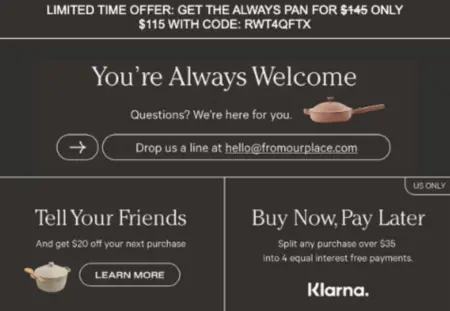
Source: Our Place

Source: Really Good Emails
If you want to talk about your brand in your email copy, Morgan Mulloy, strategic account director at Avex Designs, advises balance.
“You want to highlight your brand and the ethos behind it,” she says, “but you don’t want to provide a lengthy biography that most won’t engage with. Bite-size information that will speak to your brand will be extremely effective.”
3. Snazzy welcome email design and video assets
Your welcome email design should depend on your goals. If your goal is to showcase your products and give readers a lot of choice, you need an image-heavy design with beautiful product shots to compel people to click. Your email may look something like this one from natural wellness brand Saje:

Source: Really Good Emails
One design element to consider: adding video elements to your emails. Made In Cookware, for example, uses cooking videos—everyone’s favorite—to demonstrate the value of their products in their welcome series. When subscribers click into the video, they learn how to pan roast lamb from a high-end chef—but they also learn how to do it specifically with a Made In sauté pan. It’s a subtle product demo that doesn’t feel like one.
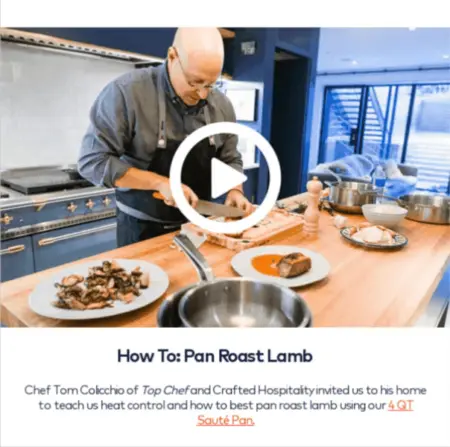
Source: Really Good Emails
4. Convincing CTAs
Some of the best welcome email examples are the ones that inspire action. The action doesn’t need to focus on a purchase, although it can—and, at some point in your welcome series, it should. But a call to action (CTA) in an email can also prompt people to:
- Take a quiz.
- Explore your products.
- Initiate a download.
- Participate in a survey.
And remember: don’t be afraid to place the CTA front and center. Check out how fragrance brand Phlur places its CTA button in the header of their welcome email, with copy that’s impossible to ignore: “Shop Now.”

Source: Really Good Emails
5. A clear value proposition
Your value proposition is the primary benefit your new customers enjoy when they’ve purchased one of your products. It’s the short and snappy answer to, “What’s in it for me?”
When someone subscribes to your list, they’ve participated in an exchange with your brand. They’ve done their part in handing over their email address, and now it’s time for you to do yours.
Oru Kayak fulfills their end of the bargain in their welcome email. The header copy, “Explore like never before,” is supported by a peaceful product image of their “beautiful origami kayaks designed for anything and anywhere.” The clear CTA, “Float On,” ties it all together to create a clear image of their value proposition.
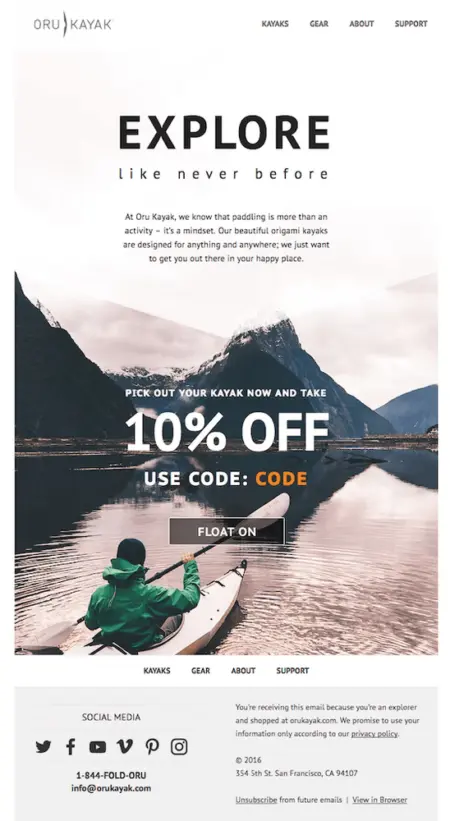
Source: Really Good Emails
6. Special offers
Special offers in welcome emails convert well. But that doesn’t mean you’re bound to the discount.
Ben Zettler, founder of Ben Zettler Digital, advises testing your offer first. “The ‘tried and true’ XYZ% off doesn’t have to be the way just because everyone else is doing it. Have you tried testing a gift with purchase? Or dollars off vs. a percentage off?”
Zettler also recommends experimenting with the structure and flow of your welcome series offer in these 3 ways:
- Use single-use discount codes generated in Klaviyo that are personalized to each recipient. Conversion rates are higher when an offer is specific to one person.
- Set a deadline for your incentive. Zettler recommends sending 3 messages that convey urgency over the course of 7 days.
- Offer a discount upgrade or extension for one day only for people who haven’t converted by the end of the week. Zettler recommends a “letter from the founder” as a way to make the last-ditch effort feel special.
What are the 4 types of welcome emails?
There’s no universal “right answer” to the type of welcome email series you should send. There’s only the right answer for your audience, which you’ll figure out through A/B testing and talking to your customers.
But if you need some inspiration, here are the 4 most common types of welcome emails:
1. The educational welcome email
A welcome email is an opportunity to educate a captive audience about your products and their value. While many brands use their welcome series as a chance to tell their brand story, proceed with caution. Subscribers are thinking, “What’s in it for me?” Before talking about yourself, you need to answer this question.
Lindsey Arellano, director of email and SMS at Curio, thinks of it like this: “Brands could provide valuable content like exclusive tips or access to a helpful resource. Providing value can help establish the brand as an authority in their field and make subscribers more likely to engage with future emails.”
Health and nutrition brand Primal Kitchen does a great job straddling the line between brand story and customer value in this welcome series email. Their mission statement—“change the way the world eats”—is supported by what provides value to their customers: “real ingredients with integrity.”

Source: Primal Kitchen
2. The offer welcome email
The first rule of welcome email flows is to send any offer you promised in exchange for a sign-up. This is how you build a foundation of trust with subscribers from the start.
If you don’t want to lead with a discount, that’s okay—your cost economics may not allow for it. But Christopher Maroney-Petitt, co-founder of Ecom Growers, recommends some experimentation with offers for “non-converters” further along in your welcome series, after you’ve already sent educational, tutorial-type emails.
“The best tactic I’ve implemented,” he says, “is an upgraded offer somewhere down in the welcome series flow. You do this if someone hasn’t converted already. That upgraded offer can be a better discount, free gift, giveaway entry, etc. If your other emails do a good job on educating, this upgrade will convert.”
If you want a point of reference for this type of welcome message, look no further than sneaker retailer Atoms. This email, sent to subscribers who haven’t converted yet, is minimalist, conversational, and something that feels like it’s coming from a friend rather than a brand. Send this type of email after you’ve educated subscribers with product-focused content.

Source: X
3. The product-focused welcome email
Similar to an educational email, a product-focused email is a great way to make sure your audience knows about your brand value from the start. Your welcome series is your chance to make a good first impression, so focus on your bestsellers or use the opportunity to introduce new products.
Here, see how olive oil brand Brightland divides their welcome email into sections that discuss the ingredients that make each product stand out:

Source: Brightland
4. The information-gathering welcome email
This type of welcome email is often overlooked, but it’s important for creating a more personalized brand experience in the long run. To give yourself the best opportunity for building long-lasting relationships with your subscribers, find out what they like and how often they want to hear from you.
Fishing brand Mystery Tackle Box gathers this information right away with their email sign-up form, but you can also use a double opt-in email to accomplish the same thing.
Here, Mystery Tackle Box promises to send subscribers “the email [they] want and nothing more,” asking whether they’re interested in the newsletter, promotions, or product updates. They also provide a lot of frequency options, so subscribers can control how often they receive emails.

Source: Mystery Tackle Box
7 welcome email best practices to make a great first impression
Now that you know the content components of a solid welcome email series, it’s also important to understand the best practices to make your welcome email sequence truly effective:
1. Introduce your brand values
Use your first email to establish your brand values. Consumers are placing greater importance on brand values when deciding where to shop—according to our future of consumer marketing report, 42% say brand values matter more in 2025 than they did a year ago.
Values such as a commitment to social and political issues, charitable contributions, carbon-neutral or zero emissions, and support for local businesses all ranked high among survey participants.
This sentiment is even stronger among younger generations: 49% of millennials and 53% of Gen Z prioritize brand values more in 2025. High spenders, defined as those who spend $100 or more on retail and ecommerce purchases, also reflect this trend: over half believe brand values matter more than before.
2. Include support contact details and unsubscribe links
In the US, the CAN-SPAM Act governs commercial email and gives people the right to opt out and unsubscribe from your email communications at any time. This is why all your emails need an obvious unsubscribe link—and it needs to be easy to unsubscribe.
Go the extra mile and include contact information for customer support, too. If you make it easy for a recipient to talk to a human being at your company, it could mean the difference between a sale and an unsubscribe.
3. Gather more zero- and first-party data
Zero-party data is information your customers give you voluntarily, like their email address or what type of pet they have. First-party data, meanwhile, is information your brand gleans directly through customer interactions with your owned channels.
You can collect zero- and first-party data through sign-up forms, website tracking, order data, email analytics, and customer service platforms—but your welcome series is also ground zero for gathering more of this valuable data from subscribers who are excited about your brand.
You may want your welcome series to include links to interactive elements like quizzes or surveys that ask people about their lifestyle preferences and shopping habits. Or, if you notice someone is interacting with your welcome email series a lot, that may be a signal it’s time to ask for their phone number.
Zero- and first-party data is hands down one of the best ways to create a personalized customer journey for your subscribers. Use your welcome series as a launchpad for personalized product recommendations and offers that have a much higher chance of conversion.
4. Use dynamic content blocks to feature the most relevant products
Your welcome email series is a great opportunity to introduce new subscribers to your best-selling products. Featuring customer favorites or trending items can help guide purchase decisions and inspire action. If you can show that other people love certain products, you can reduce the perceived risk of buying.
Consider using dynamic content blocks that pull information from your online store to showcase top-rated products, best-sellers in relevant categories, or items based on the subscriber’s browsing behavior. When you pair these product highlights with social proof (more on this next), you’re boosting interest and trust.
5. Highlight social proof
Speaking of social proof, it’s one of the most effective ways to build credibility and encourage conversions. Authentic feedback—especially from customers who share similar interests or pain points—can help subscribers situate themselves as customers.
To show new subscribers that other people love your brand, reinforce brand value, and reduce hesitation around making a purchase, consider including the following in your welcome emails:
- Customer reviews
- Testimonials
- Star ratings
- User-generated content
6. Offer a special welcome discount code
A well-timed incentive can be the nudge needed to turn a subscriber into a paying customer. According to our future of consumer marketing report, economic conditions have led more than one-third (37%) of consumers to seek out discounts and promotions from ecommerce and retail brands.
Consider offering a limited-time promo code or exclusive first-purchase discount to create a sense of urgency. Be strategic in your messaging—rather than framing it as just a discount, position it as a special thank-you for joining your brand’s community. Combine the offer with product recommendations or a call-to-action to shop now to further drive conversions.
7. Time your welcome email series just right
Your first email should go out immediately after someone signs up for your list. After that, we recommend at least a day between emails so that you’re not slamming people’s inboxes.
But timing isn’t just about timing—it’s also about segmentation. When your email list starts to include thousands of people, things can get a little messy. To keep unsubscribe rates low and engagement rates up, you’ll need to “protect” people in your welcome series from receiving all the other emails you send, too.
Eric Miller, director of CRM and email at Tinuiti, puts it this way: “For email subscribers who are currently in the welcome series, suppress them from calendar sends. They aren’t ready for your full cadence. They’re still evaluating you and you haven’t earned their trust yet.”
How to automate your welcome emails
Sending a well-timed email series to thousands of recipients isn’t easy. But you don’t need to do it manually.
Email marketing automation is what allows brands to send personalized emails at scale, which essentially means you can make money from your email marketing strategy in your sleep.
With automation, you just need to set up your welcome email series once. Then, your email automation platform takes care of sending the emails to customers when they sign up. Here’s how to make this work for your welcome series:
Use Klaviyo email flows
When you’re building your welcome series, you won’t need to start from scratch. Klaviyo provides a pre-built welcome series flow that you can build on.
Setting up a welcome email series in Klaviyo involves 3 simple steps:
- Connect your email list.
- Define your triggers.
- Customize your email content and style.
If you don’t want to use the pre-built welcome email flow, you can also design a welcome email flow from scratch. Klaviyo offers multiple welcome email templates for you to choose from.
Go multi-channel
To boost engagement and conversions, combine email with SMS marketing. If you can get a phone number as a next step to providing an email address, you can send both a welcome email and a welcome text message—and ask how people prefer to be contacted in the future.
Automated SMS welcome flows are similar to email, but you can do some slightly different things with them. Use SMS to:
- Make it easy for subscribers to state their communication preferences.
- Offer exclusive mobile-only deals.
- Provide quick links to products or content.
- Encourage two-way communication for better engagement.
A multi-channel approach is a great way to meet customers where they are, which can ultimately increase conversion rates.
A/B test welcome emails to optimize engagement
You won’t know what’s working until you A/B test. And Klaviyo makes it easy to test your welcome email series.
A/B test various welcome email parameters with what’s called “conditional splits” in your welcome email flow.
A conditional split creates two branches in your welcome email flow, each creating a different experience based on a set of parameters. Test variables like:
- The target audience
- The timing of emails
- The frequency of emails
Track your welcome email performance
You can’t improve what you don’t measure. As you refine your welcome series through A/B testing, watch your email performance like a hawk. That means keeping track of the following metrics:
- Click rate: the percentage of recipients who click on a link within your welcome series
- Conversion rate: the percentage of recipients who take action after they click your welcome series
- Revenue per recipient (RPR): how much money every welcome email series recipient is bringing in
- Deliverability rates: the percentage of welcome series emails that makes it to your recipients’ inboxes
- Unsubscribe rate: the percentage of people who receive your welcome series and then unsubscribe from your list
- List growth rate: the rate at which you’re acquiring new subscribers to your list
- Return on investment (ROI): the financial return from your welcome series compared to the money you’ve spent
With Klaviyo reporting, you can track these metrics at a glance on your dashboard.
Measure your brand against welcome email benchmarks
Curious about what “good performance” looks like for the typical welcome series? According to the latest Klaviyo email benchmarks, welcome series emails earn high open rates, conversion rates, and RPR, which makes the automation one of the most effective series of emails you can send.
Here’s what to expect:

Source: Klaviyo email benchmark report
Monitoring email marketing statistics and industry benchmarks empowers you to fine-tune your strategies, understand your audience better, and make informed decisions that lead to more successful and impactful email campaigns. Benchmarks may vary based on industry, however, so check out your category to see what to expect from your welcome email series.
Welcome email FAQs
How do I write a good welcome email subject line?
Write a good welcome email subject line by using the recipient’s first name, keeping it clear and brief, and evoking a sense of curiosity that encourages people to open your email just to find out what’s inside.
How many emails should be included in a welcome email sequence?
The number of emails in your welcome email sequence depends on the length of your average purchase cycle. If it takes potential customers an average of 20 days to purchase from the moment of discovery, your welcome series should reflect that to avoid losing sales.
What is the business impact of a welcome email?
The business impact of a welcome email is, on average, $2.35 in RPR. Welcome emails also earn a high average open rate of 51.26% across all industries, in addition to an average placed order rate of 1.97%.
What are some common mistakes to avoid in a welcome email?
A welcome email sets the stage for your brand’s relationship with new subscribers, so avoiding missteps is crucial. Here are some common mistakes to steer clear of:
- Skipping personalization: Generic greetings like “Dear customer” can make your email feel impersonal. Instead, use first names, reference how they signed up, and if you can, include product recommendations that are tailored to browsing behavior at some point in your sequence.
- Lacking a strong CTA: Your welcome email should guide subscribers toward a next step, whether it’s shopping, following on social, or updating preferences.
- Neglecting mobile optimization: Most people open emails on mobile devices. If your email isn’t mobile friendly, you risk losing engagement.
- Forgetting to include an unsubscribe link: It’s legally required and builds trust. Make it easy for people to manage their subscription preferences.
What are the benefits of a welcome email series?
A welcome email series benefits your brand, your customers, and your sales. Here are some of the immediate benefits:
- Stronger brand connection: A sequence allows you to introduce your brand’s story, values, and bestselling products over time.
- Higher engagement rates: Klaviyo benchmarks show that welcome email series have some of the highest open and conversion rates compared to other automated flows.
- Better customer segmentation: With multiple touchpoints, you can gather more first-party data and tailor future messaging based on subscriber actions.
- Increased revenue potential: By offering personalized product recommendations and exclusive discounts, a well-timed welcome series can drive immediate conversions.
Why do marketers send welcome emails in the consideration stage of the marketing funnel?
The welcome email is an important touchpoint in the consideration stage, when subscribers are evaluating your brand but haven’t yet made a purchase. A carefully crafted welcome email series can educate potential customers and remind them of the value of your brand.
Marketers also use welcome emails to speed up time to purchase. A timely discount or new product feature can nudge potential customers toward making a purchase. Even if subscribers don’t convert immediately, keeping your brand top of mind through consistent engagement can lead to conversions down the line when they’re ready to buy.

Related content
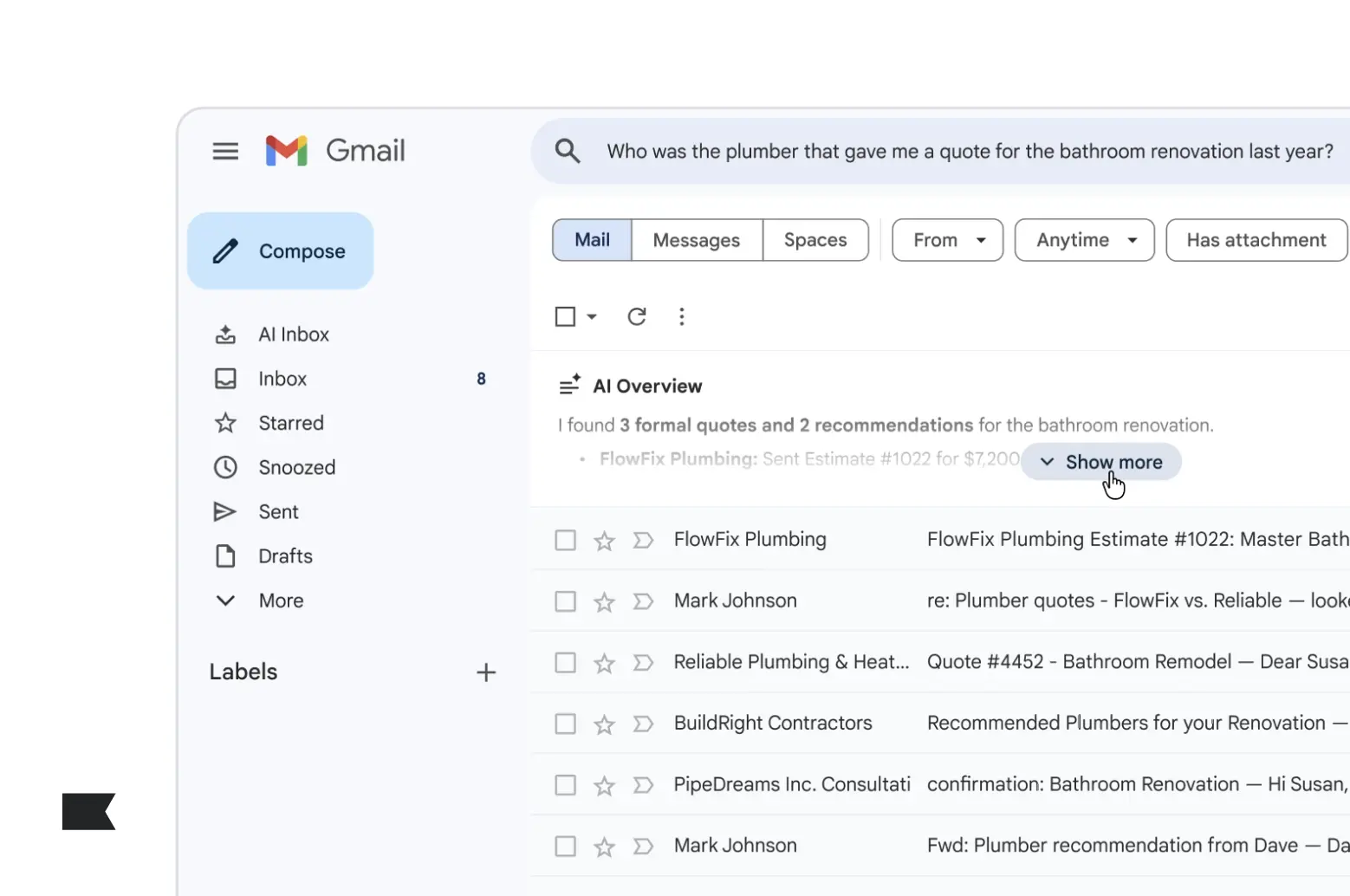
Google is bringing Gemini AI directly into Gmail, changing how emails are summarized, prioritized, and acted on. Here’s what retail marketers need to know—and how to adapt.

Discover the best email marketing platform for ecommerce in 2026. Compare top tools for data, automation, personalization, and deliverability.
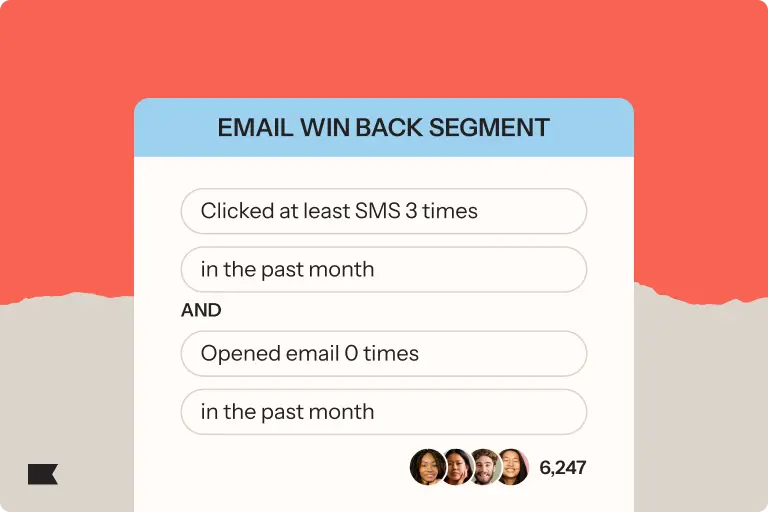
Learn how to use Klaviyo SMS, segmentation, and hybrid flows to re-engage lapsed email subscribers, boost deliverability, and drive higher retention.